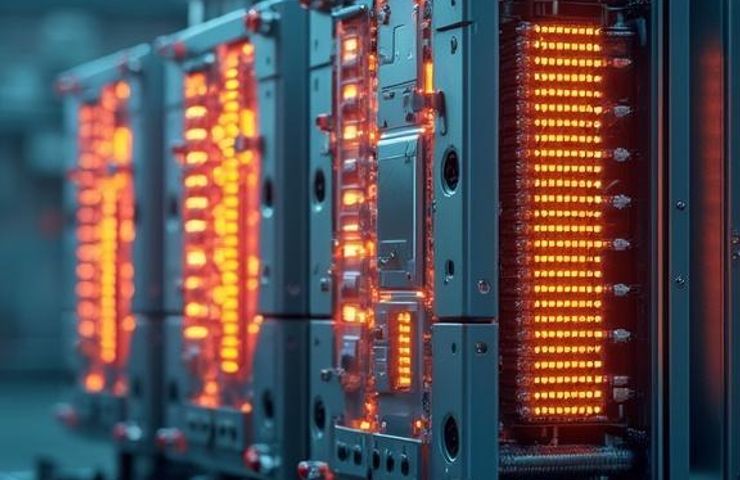
Solid Oxide Fuel Cells: The Next Big Leap in Clean Energy Systems
July 28, 2025Say goodbye to smokestacks — and power grid bottlenecks while you’re at it. Solid oxide fuel cells (SOFCs) are stepping out of the lab and into the real world, and they’re bringing some serious clean energy game with them. These systems run quietly, deliver electricity with awesome efficiency, and leave the smoke and flames behind. No combustion, no noise, no nonsense. Thanks to innovators like Elcogen, Bosch and others, this once high-tech dream is fast becoming a practical energy solution for everything from factories to vehicles.
What This Means
Let’s be real — the old energy playbook is falling apart. Coal and gas systems are outdated, dirty, and wildly inefficient. And our centralized grids? Losing juice over long distances isn’t exactly ideal. That’s where SOFC technology flips the script. These high-temp fuel cells can run on hydrogen, natural gas, biogas — even ammonia — and dish out both electricity and heat with barely any emissions. It’s a clean energy multitool, perfectly made for decentralized, flexible power wherever you need it most.
The Technology: The Magic Ingredient
Here’s the cool part — SOFCs work using ceramic electrolytes that move oxygen ions at scorching temperatures of 600–1000°C. Sounds intense, right? But what you get from that is pure electricity and usable heat — no flames, no smoke. Now, mix in next-gen intelligent control algorithms and it gets even better. These smart systems adapt to your needs on the fly: rebalancing fuel use, protecting hardware from stress, and kicking out max performance. If clean energy had a brain, this would be it.
Strategic Angle
There’s serious momentum behind this tech. In northern Europe, Elcogen — based in Estonia — is making modular SOFC stacks that are already helping decentralize power across the continent. Backed by decades of R&D and EU energy programs, they’re replacing fossil-based systems in local grids, transport, even portable units. Meanwhile, German tech giant Bosch is taking it to the next level, developing SOFCs built for large-scale rollout across industrial sites and smart grids. And with Europe putting major bets on hydrogen, these two are already miles ahead in the game.
Real-World Application
This isn’t just some clean-tech idea getting kicked around at conferences — it’s already out there, being tested and deployed. Bosch’s fuel cell modules are built for decentralization—think urban buildings, industrial facilities, hospitals, campuses. They not only pump out clean power, but repurpose waste heat too. That means diesel generators for backup? Out. Same goes for fuel-hungry heating systems. And when it comes to mobility, SOFC use in ships, trucks, and even aerospace is gaining serious interest. Clean transport powered by SOFC technology is officially on the move.
What Makes It a Big Deal?
- Over 60% electrical efficiency — blowing past most traditional generators.
- Ultra-low emissions — no combustion means cleaner air, period.
- Fuel flexibility — start with hydrogen today, switch to ammonia or biogas tomorrow.
- Waste heat reuse — ideal for Combined Heat and Power (CHP) setups.
- Scalability — from single homes to whole neighborhoods or factories.
Zooming Out: Market Forces & Collateral Impacts
This market isn’t crawling — it’s sprinting. By 2025, the global solid oxide fuel cells sector is pegged to hit $2.85 billion, with a jaw-dropping growth rate of 28% annually. What’s fueling that surge? Forward-thinking policy, strong public-private partnerships, and Europe’s all-in push for clean energy systems and hydrogen integration.
Sure, it’s not all smooth sailing. SOFCs need high-quality materials, which aren’t cheap. The manufacturing process is still tricky, and the heating-cooling cycles can wear things down. But that’s where new advanced materials and smarter, low-cost production methods are already stepping in. Governments are throwing weight behind the tech with localized incentives and funding, knowing this shift is essential.
And the ripple effect? Lower emissions across whole communities. New clean-energy careers. Less strain on big grids. Whole industries getting a new lease on life by dumping coal. This is how you redefine the energy ecosystem — one scalable cell at a time.
Final Shot
This isn’t just another battery or backup system. SOFC technology is a straight-up disruptor — delivering flexible, efficient, and super-clean energy that actually makes sense in the modern world. If you’re talking about building a future-proof power system and not factoring in solid oxide fuel cells, you’re missing the plot entirely.
Elcogen and Bosch aren’t just designing sleek tech — they’re reimagining how we power everything. The era of grid-tied, high-emission, fossil-fueled energy is fading fast. And in its place? Smart systems, hot ceramics, and a new standard for what clean energy really means. The future’s firing up — and it’s hotter (and cleaner) than ever.



 With over 15 years of reporting hydrogen news, we are your premier source for the latest updates and insights in hydrogen and renewable energy.
With over 15 years of reporting hydrogen news, we are your premier source for the latest updates and insights in hydrogen and renewable energy.